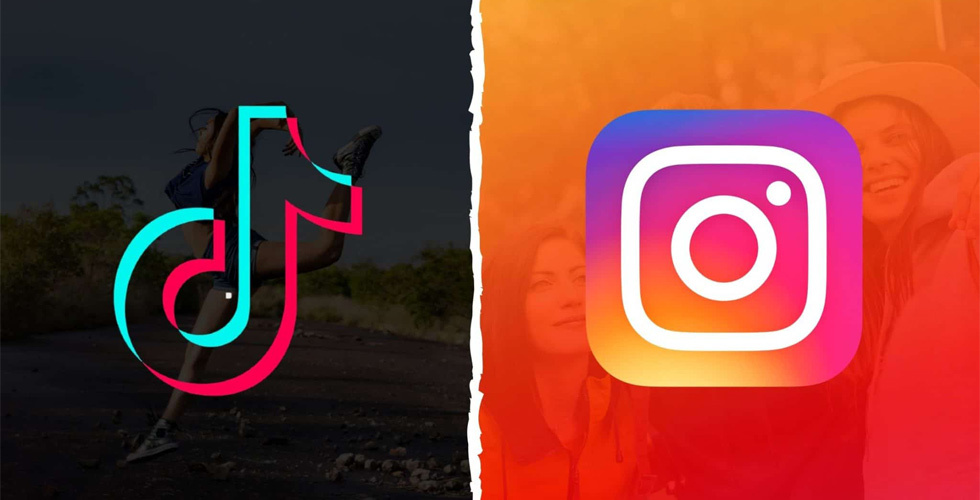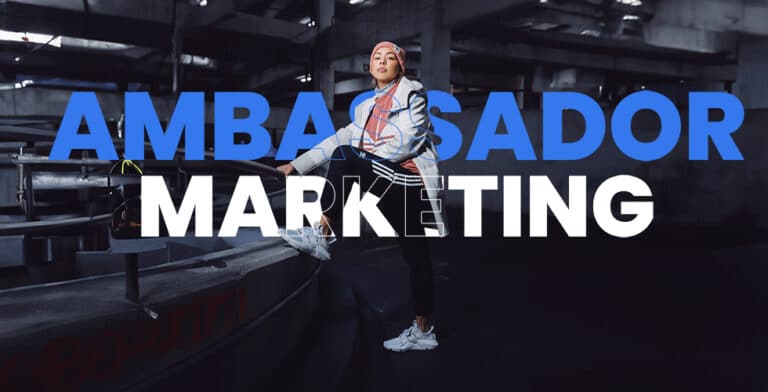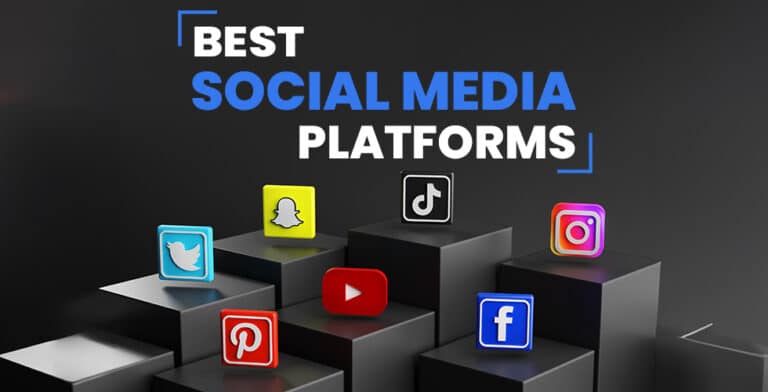Influencer marketing has exploded in popularity in recent years. An estimated $9.7 billion was spent on influencer marketing in 2020, and that number is expected to grow to $22.2 billion in 2025, According to Statista. Two of the biggest platforms for influencer marketing are Instagram and the upstart TikTok.
Instagram has been a go-to for influencer marketing for brands for years now. There are currently 200 million business accounts on Instagram. Over 90% of Instagram users follow at least one business, and influencer marketing is a key strategy on the platform. TikTok, meanwhile, has seen meteoric growth since launching globally in 2018. It now has over 1.1 billion monthly active users, making it a force for brands to be reckoned with.
Both platforms offer opportunities for impactful influencer marketing campaigns but have key differences in terms of audience, content style, commerce capabilities, and more. For brands considering an expansion into TikTok influencer marketing, it’s important to understand these differences to develop an optimal strategy.
TikTok and Instagram Audience Demographics
When developing an influencer marketing strategy, understanding the core audience on each platform is key. TikTok and Instagram have some overlaps but also major differences in terms of age, gender, geographic location, and other demographic factors.
1. Age of Users
The TikTok audience skews very young. As of July 2023, the age distribution of TikTok’s global audience is as follows:
- 18-24 years: 37.3% (19.5% female, 17.8% male)
- 25-34 years: 32.9% (16.3% female, 16.6% male)
- 35-44 years: 16.5% (7.9% female, 7.8% male)
- 45-54 years: 7.5% (4.3% female, 4% male)
- 55+ years: 5.5% (3.2% female, 2.6% male)
Therefore, the percentage of TikTok’s global audience between the ages of 10 and 49 in 2023 is more than 90%. Less than 10% of users are over the age of 50.
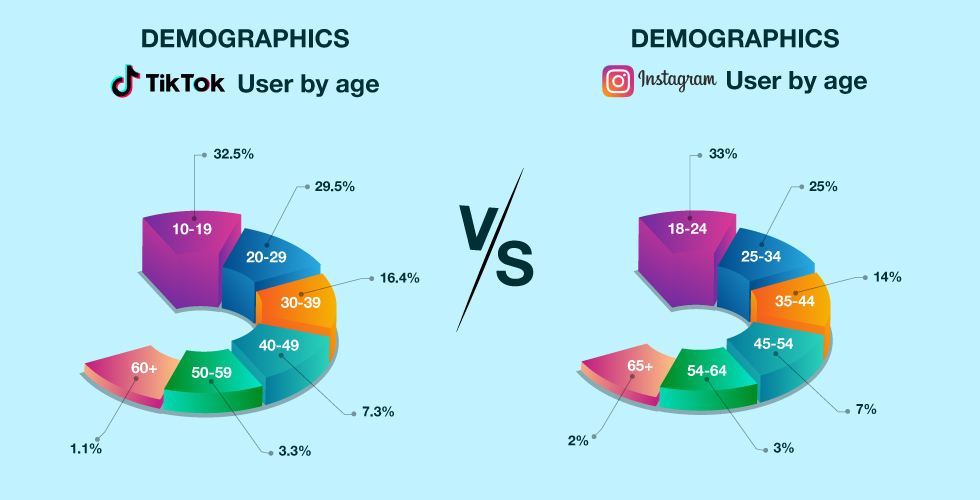
TikTok’s audience is primarily made up of Generation Z. The app has found massive popularity among teenagers and young adults.
Instagram, however, has an older and more evenly distributed user base. According to Hootsuite, roughly 31.5% of Instagram’s worldwide users are aged 25-34 years old, with 30.1% between 18-24 years old and 24.1% between 35-54 years old.
Millennials make up the biggest share of Instagram’s audience. But a significant portion of Generation Z and some older demographics are also present.
This age difference has a major impact on content and influencer selection for brands. We’ll cover that more later on.
2. Gender Breakdown
TikTok has a relatively even gender split, with about 57% of global users identifying as female and the rest identifying as male. Instagram’s audience also leans more female, with 48.2% of users identifying as male and 51.8% identifying as female in 2023.
Brands that want to connect with a mostly female audience may find stronger options among TikTok influencers.
However, TikTok’s audience is large enough that major brands still have plenty of opportunities to reach female users. The gender split is something to keep in mind though.
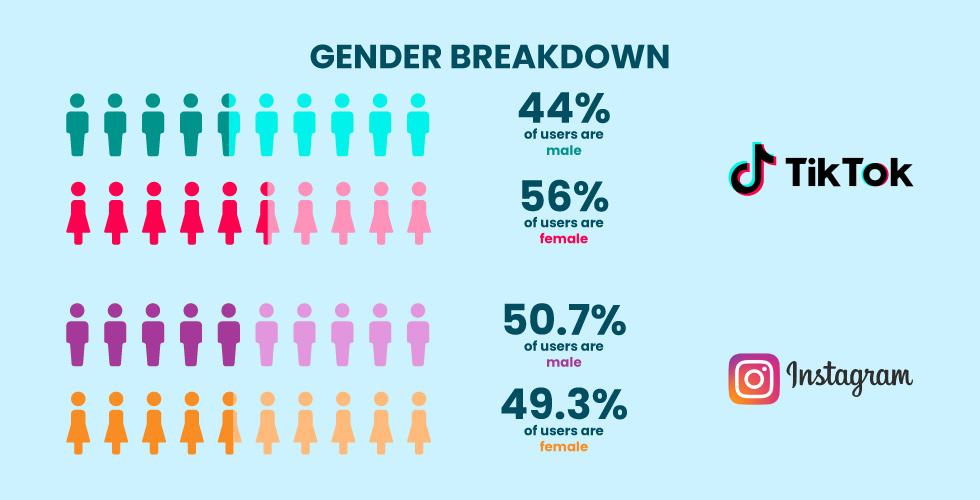
3. Geographic Reach
TikTok has its strongest user bases in Indonesia and the United States, where it has 116.5 million and 113.0 million active TikTok users aged 18 and above.
Instagram is the most popular social platform, with over 2.35 billion monthly active users worldwide, and expected to reach 2.5 billion by the end of 2023. But its four largest user bases are in the U.S., Brazil, Russia, and India.
Certain regions like India have restrictions that limit TikTok’s reach. But both platforms have managed to build large global audiences.
For most brands, geographic differences won’t be a major concern in the TikTok vs Instagram decision. There are popular influencers on both platforms that can appeal to audiences across various countries.
4. Key Demographic Differences
TikTok caters to a Gen Z teenage and young adult audience, while Instagram has a more even distribution across age groups.
Instagram users skew more female, while TikTok has near gender parity. And TikTok is still gaining traction globally, while Instagram has broad worldwide popularity.
Content Style and Engagement on TikTok vs Instagram
When developing influencer marketing campaigns, it’s important to tailor the content style and messaging to resonate with each platform’s audience. TikTok and Instagram have significant differences in the type of content that performs well and drives engagement.
1. Content Formats
On TikTok, short videos rule. The platform is built for easily creating and sharing 15 to 60 second video clips. Effects and hashtags drive viral sharing.
On Instagram, photos still dominate, but IGTVs and Reels allow for longer-form video. The focus is on highly produced, polished visuals.
TikTok’s constraints around video length and orientation create a very different style than Instagram’s mix of content formats.
2. Content Production Value
TikTok content feels more spontaneous, raw, and unrehearsed. Quick cuts, jumps, and informal shooting styles are popular.
Instagram favors pristine, carefully crafted images and videos with good lighting and editing. Influencer content feels more posed and professionally produced.
Instagram influencers put a premium on high-quality images and videos. TikTok is more about personality and organic videos.
3. Engagement Rates
In general, the average engagement rate on TikTok posts is over 15.86%. In the USA, sometimes influencers see a bigger engagement rate which is nearly 18%.
For Instagram influencer sponsorships, the engagement rate was more than 8%. This report is based on research conducted by TrendHero on 7.5 million Instagram accounts. However, Instagram still drives more absolute engagement due to its larger user base.
When it comes to total time spent –
- TikTok has extremely high engagement, with users spending 52 minutes per day on average.
- Instagram sees lower engagement overall, with 28 minutes spent per day on average.
TikTok’s full-screen vertical video format leads to more attentive viewing and engagement. Instagram’s content gets lost in the feed more easily.
4. Key Content and Engagement Differences
TikTok is the place for authentic, fun short-form videos while Instagram emphasizes visual polish. Engagement rates are currently higher on TikTok, but Instagram offers scale. Brands must optimize content style for each accordingly.
Next, we’ll explore how brands can tap into influencer marketing on both platforms.
Influencer Marketing Opportunities on TikTok and Instagram
When considering the right platform for an influencer campaign, brands must assess the unique opportunities each presents for audience reach, content creation, and driving business results. Both TikTok and Instagram offer compelling options.
1. Influencer Campaign Potential
TikTok is ideal for raising brand awareness and exposure with a younger demographic. Fun, viral challenges and trends can attract Gen Z audiences.
Instagram provides extensive reach across age groups, and influencer collaborations drive tangible sales via in-app shopping features. According to TikTok, 63% of TikTok users say they like brands when they see content creators on the videos.
- On TikTok, creative influencer campaigns can often go viral, generating huge view counts. Top influencers like Charli D’Amelio are experts at creating viral content.
- On Instagram, influencer posts generate strong engagement and clicks through to products and sales pages. Mega-influencers like Kylie Jenner are masters of driving commercial success.
So TikTok generates greater brand awareness while Instagram drives more direct sales through influencer posts.
2. Types of Influencers
There are also differences in the dominant types of influencers on each platform:
- TikTok favors up-and-coming “nano” and “micro” influencers who create authentic content focused on trends and memes.
- Instagram has a large base of powerhouse celebrities and macro influencers with ultra-polished feeds. They tend to be more expensive at higher tiers.
TikTok’s algorithm makes it possible for nano and micro-influencers to gain a large following quickly if their content resonates.
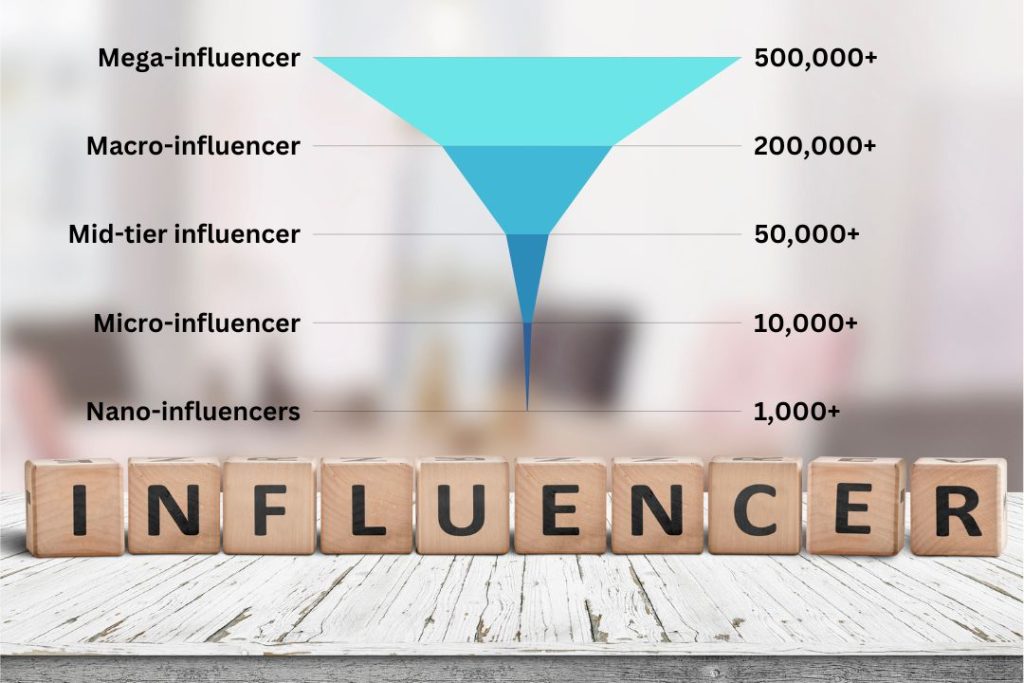
Instagram favors those with pre-existing fame and an aspirational lifestyle. Mid-tier and celebrity influencers have the most sway.
According to Aspire.io, nano-influencers have an average engagement rate of 3.69% compared to micro-influencers standing only half of the number.
3. Commerce Features
TikTok is still developing its e-commerce capabilities but launched TikTok Shopping in 2021. However, influencer content can drive traffic to websites.
Instagram offers built-in shopping and “swipe up to shop” features that seamlessly facilitate in-app sales. Hubspot reports that 49% of Gen Z consumers discover new products on Instagram stories.
4. Key Influencer Marketing Factors
To quickly summarize, some keys to consider for each platform:
- TikTok – Viral content potential, micro-influencers offer good value, less commerce-focused
- Instagram – Broad influencer capabilities, strong visual branding, advanced commerce options
In short, TikTok is better for awareness while Instagram converts. Opt for nano/micro-influencers on TikTok and bigger names on Instagram. Instagram more directly delivers ROI from influencer partnerships.
Next, we’ll look at some examples of successful campaigns on both platforms.
Examples of Successful TikTok and Instagram Influencer Campaigns
Looking at influencer marketing campaign examples on TikTok and Instagram can help showcase the success brands can achieve on each platform.
1. Case Study: ELF Cosmetics #eyeslipsface TikTok Hashtag Challenge
In 2019, ELF cosmetics ran a TikTok hashtag challenge campaign including Jessica Alba, prompting users to create makeup tutorial videos. All over the world, there are now 3 million user-generated videos currently.
They used a hashtag – #eyeslipsface, videos with this was viewed 4 billion times, and now it is standing at 9.4+ billion views. TikTok reported it as one of the most successful hashtag challenges of the year.
This campaign leveraged TikTok’s viral potential for massive brand exposure. The micro-influencer partnerships kept costs down while generating huge reach.
2. Case Study: Daniel Wellington Instagram Influencer Campaign
Watch brand Daniel Wellington started in 2011 with just $1500. They avoided typical marketing channels and focused on micro-influencer collaboration on Instagram targeting Gen Y.
- First, they launched the Iconic Link Series watches and collaborated with 3000+ lifestyle Instagram influencers globally
- The influencers showcased the watches on their highly curated feeds
- This generated over 2500 Instagram posts with 1.3 billion total impressions
- Now Daniel Wellington earning roughly $200 million in revenue
Daniel Wellington tapped into Instagram’s broad influencer base and brand-safe environment. The campaign drove massive awareness through brand-appropriate content.
3. Key Takeaways for Influencer Marketing on Each Platform
These examples demonstrate how brands of any size can tap into influencer marketing successfully on both TikTok and Instagram.
- TikTok is better for raising brand awareness through viral content. Leverage micro-influencers for value.
- Instagram drives sales through influencer posts. Macro-influencers have a major commercial impact.
In other words, TikTok offers unparalleled exposure, while Instagram delivers direct-response conversion.
Tips for Running Successful Influencer Campaigns on TikTok and Instagram
When executing influencer marketing campaigns on these platforms, brands should follow best practices to optimize results. Here are some top tips:
1. Partner With the Right Influencers
Vetting and selecting the right influencers is crucial for campaigns on both TikTok and Instagram. Take time to thoroughly assess influencer options to find ones that truly match your brand and campaign goals.
Look beyond just follower count – make sure their audience demographics and interests align with your target market. Analyze engagement rates, comment sentiment, video views, likes, and other metrics to choose influencers with the highest quality engagement.
Review content style and production value to ensure alignment with your brand aesthetics and campaign vision. Influencer values and brand affiliations also matter, especially for reaching Gen Z on TikTok who care about authenticity.
Take a consultative approach to explain campaign goals and ideal messaging so you find influencers excited to creatively collaborate.
- On TikTok, work with up-and-coming micro and mid-tier influencers in your niche who create engaging, original content. Avoid fake engagement.
- On Instagram, go after recognizable macro-influencers and celebs along with some mid-size fits. Ensure content will match their polished feeds.
2. Set Clear Expectations
Leave no room for miscommunication by outlining very clear expectations with influencers through detailed campaign briefs and contracts. Provide all relevant background on campaign objectives, desired tone and messaging, target audience insights, and ideal content formats.
Set a posting calendar outlining the exact number of posts expected and schedule for publishing – build in flexibility for influencers to have creative input. Specify your approval process and timing for reviewing all content before public posting.
Share guidelines for FTC disclosure requirements based on content type and placement. Outline how you will track performance using UTM parameters, promo codes, pixels, and platform analytics. Define success metrics and KPIs like impressions, engagement rate, traffic, and conversions so incentives align.
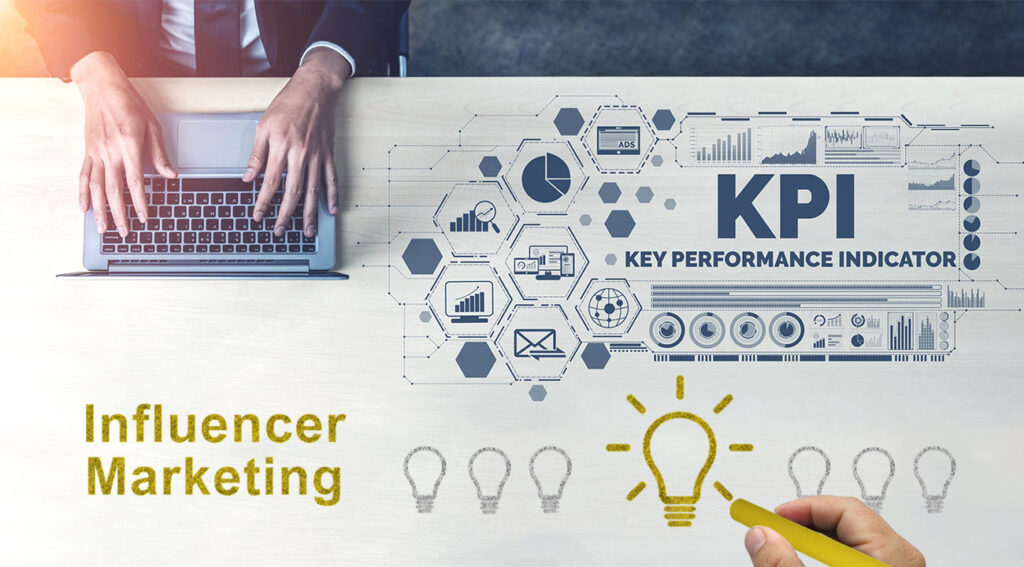
3. Track Performance Closely
Closely monitoring and optimizing campaigns in real-time is key for TikTok and Instagram influencer marketing success. Use analytic tools to gain visibility into traffic, clicks, video views, engagements, conversions, and sales driven by creators.
Look at performance by post, creator, and day part to identify top-performing content to help guide ongoing efforts. Monitor engagement rate trends to make sure influencer content continues resonating over time, adjusting strategies if needed.
Use Urchin tracking module (UTM) campaign tags, unique landing pages, and promo codes to accurately attribute conversion value. Follow Instagram and TikTok algorithm updates and adapt content accordingly. Provide influencers with performance data feedback to help them optimize efforts. Continually optimize towards KPIs to maximize Return on Ad Spend (ROAS).
4. Amplify with Ads
Efficiently scale the reach of high-performing organic influencer content through paid amplification on both platforms. Use TikTok’s In-Feed Video Ads to retarget users who engaged with a brand’s hashtag challenge to drive awareness.
Test Instagram Reels promotion to expand viewership of top influencer videos. Create Instagram Stories ads to expose more users to swipe up product links. Make sure to maintain cost-efficiency despite amplifying spend.
Measure the impact on important metrics like new followers, engagement rate, website traffic, and conversions. Audit and optimize paid support to ensure positive ROI. Amplification can expand influencer impact but requires diligent monitoring.
Properly executing influencer campaigns takes work. But the payoff in brand awareness and sales can be immense.
Key Metrics to Compare TikTok vs Instagram Influencers
Here is a quick recap of some of the key TikTok vs Instagram metrics we covered:
| Metric | TikTok | |
| Top Age Demographic | Gen Z (16-24) | Millennials (25-34) |
| Content Style | Raw, authentic, casual | Polished, edited, curated |
| Engagement Level | Very high | Moderate |
| Campaign Value | Brand awareness | Driving sales |
| Top Influencer Type | Micro-influencers | Powerhouse celebs and macros |
These differences help summarize the opportunities on both platforms for influencer marketing.
Instagram is the more established platform with better commerce options. But brands shouldn’t underestimate the power of TikTok’s viral content and younger demographics.
The best approach is to test influencer campaigns on both TikTok and Instagram. See which platform and content style resonates most with your brand and audience.
How to Choose the Right Influencer?
When vetting influencers on TikTok and Instagram, brands should analyze a number of key metrics to assess audience quality and expected campaign performance.
Top metrics to compare include:
- Follower Count: Total followers is important on Instagram, while engagement rates matter more than the size on TikTok
- Engagement Rate: Engagement benchmarks are higher on TikTok than Instagram
- Video Views: Consider views for both platforms but with quicker content consumption on TikTok
- Traffic Potential: TikTok drives awareness while Instagram delivers clicks and conversions
- Audience Interests: Ensure influencer content and followers align with brand targeting
- Content Style: Assess for brand fit, quality, and consistency across both platforms
Analyzing these metrics holistically for influencer accounts on TikTok and Instagram can inform partnership decisions and set performance expectations. Brands must select creators that can deliver on each platform’s unique value in driving campaign success.
Conclusion: Leverage Both Platforms for Influencer Marketing
The verdict on TikTok vs Instagram? There isn’t one singular winner – each platform offers unique advantages.
Smart brands will leverage influencers on both TikTok and Instagram. TikTok is ideal for edgy, viral content to raise brand awareness among Gen Z users. Instagram unlocks partnerships with powerhouse influencers who can directly drive sales.
Audience demographics, content style, and influencer opportunities differ on TikTok and Instagram. But both remain essential platforms for influencer marketing in 2023 and beyond.
At the end of the day, focus on the goals for your specific brand and campaign. Then determine whether TikTok or Instagram influencers are a better fit. In most cases, having a presence on both platforms is the best approach.
To recap, here are some of the core benefits of each platform:
Key Benefits of TikTok for Influencer Marketing
- Reach younger Generation Z audiences
- Launch viral content and challenges
- Leverage authentic micro-influencers
- Build brand awareness rapidly
Key Benefits of Instagram for Influencer Marketing
- Access a broad spectrum of demographics
- Partner with celebrity mega-influencers
- Showcase products in aspirational contexts
- Drive direct sales through shoppable posts
What are you waiting for? It’s time to tap into the massive opportunities of working with influencers on TikTok and Instagram today. Will your next viral video or sales sensation come from TikTok or Instagram? The possibilities are endless on both platforms.

